If you're new here, you may want to subscribe to my RSS feed. Thanks for visiting!
by Lyza Hayn
Want to forage for wild food? It’s easy when you live in a wild place. However, those dwelling in more domestic areas face challenges when it comes to plant diversity and availability. The good news is that city slickers don’t have to be left out of the fun.
They just have to think outside the box.
While urban landscapes don’t offer the smorgasbord of tasty edibles you’ll find in an actual forest, they can be a veritable treasure trove of vital nutrients — if you know what to look for.
5 Edible Plants to Forage in the City
The following list is by no means exhaustive. It’s simply a jumping-off point featuring five edibles that are plentiful, nutrient-rich, and easy to identify. Once you’ve got these down pat, you can move on to rarer plants and more region-specific wild foods.
1. Dandelion
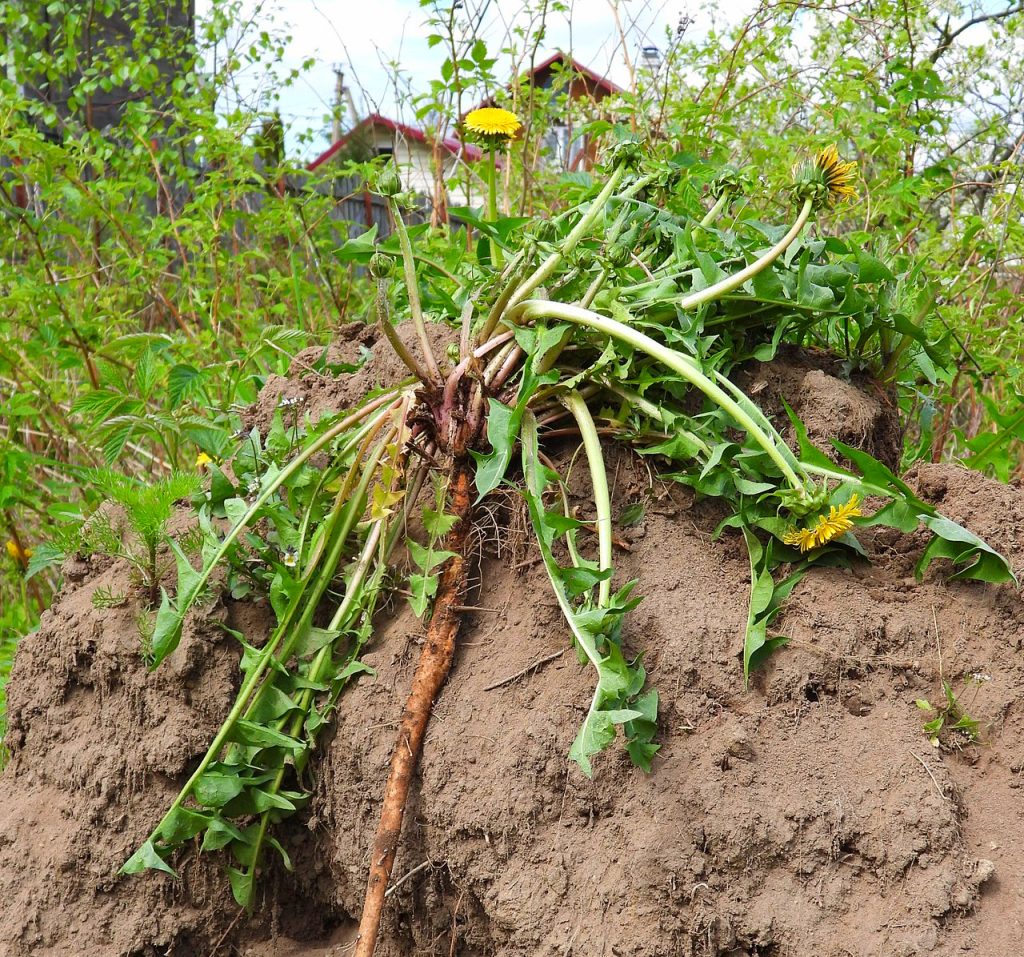
Know in the scientific community as Taraxacum officinale, dandelion is a persistent perennial that grows on every continent except Antarctica. Not only is it a mild antimicrobial agent you can use for personal hygiene when SHTF, but it’s also a delicious and incredibly nutritious urban edible.
When: Dandelion can be found from early spring to late autumn. However, harvesting the greens in late spring or early autumn is best. They are the freshest and most tender before the flowers bloom, but will remain palatable until they disappear for the winter.
Where: Dandelion is incredibly resilient and thrives even in the worst circumstances. You might find this bright flower in your own yard or the common outdoor areas of an apartment complex. It grows in open meadowy areas and is a frequent flyer in parks, roadsides, and ditches. Dandelion will even sprout from between pavers or from the sidewalk!
How: Dandelion flowers, roots, and leaves are all good to eat. You must cook the roots—they’re good roasted, steamed, or even fried. The bright yellow blooms add a dash of succulent color to teas, salads, and baked goods. The green leaves are packed with nutrients and present a powerhouse of vitamins A, C, K, and manganese. You can blend them in smoothies, stew them, or eat them raw in salads.
2. Purple Dead Nettle
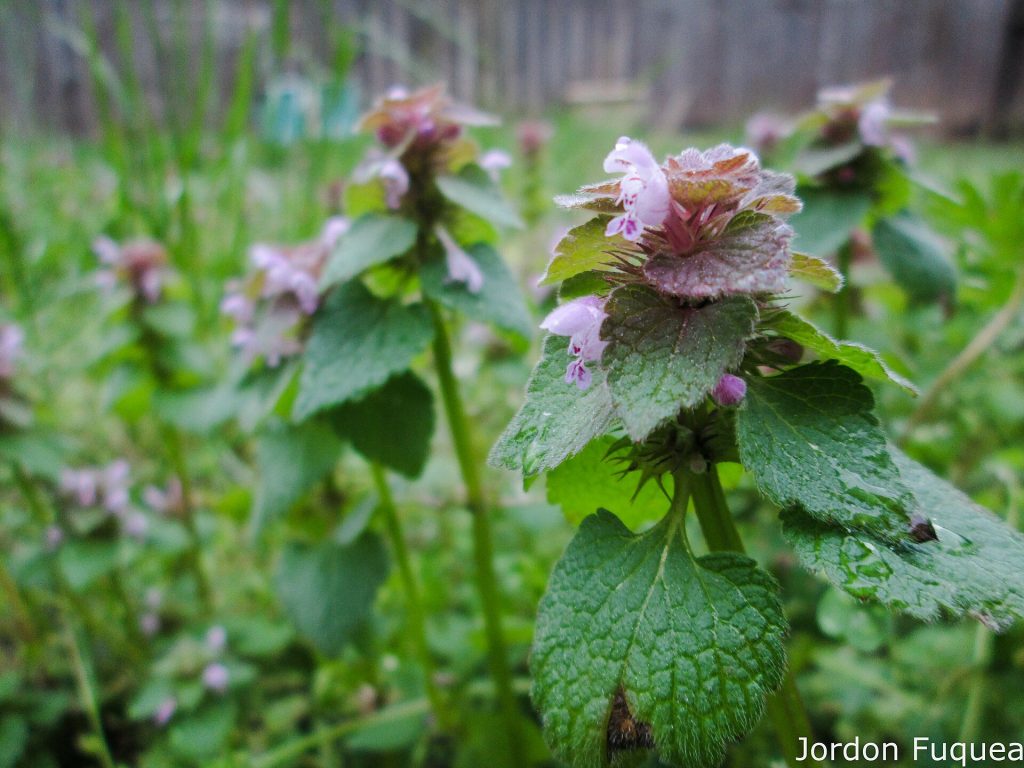
Purple dead nettle, or Lamium purpureum if you’re feeling fancy, is a harbinger of spring and a proud member of the mint family. With tiny yet captivating purple blooms and distinct stacks of serrated triangular leaves, this low-lying plant scores sky-high in health and nutrition.
When: Purple dead nettle is often the first wild edible you can forage once the snow melts. It appears in early springtime and might hold its own for a month or two, but forage while you can. This plant is not competitive and will die off as the season heats up and heartier species come in.
Where: Purple dead nettle obliterates my lawn in early spring. It will grow around city parks, cemeteries, yards, or walking trails. Look down seldom-used roadsides to find thick patches, or scour the planters of local businesses to snag a few leaves.
How: Purple dead nettle is packed with antioxidants, vitamins, fiber, and even has a bit of iron. Its purplish leaves and flowering tops make an excellent tea, salad add-in, or smoothie base. You can cook with purple dead nettle just like spinach or kale, or dry it and use it as an earthy herb.
3. Perilla Mint
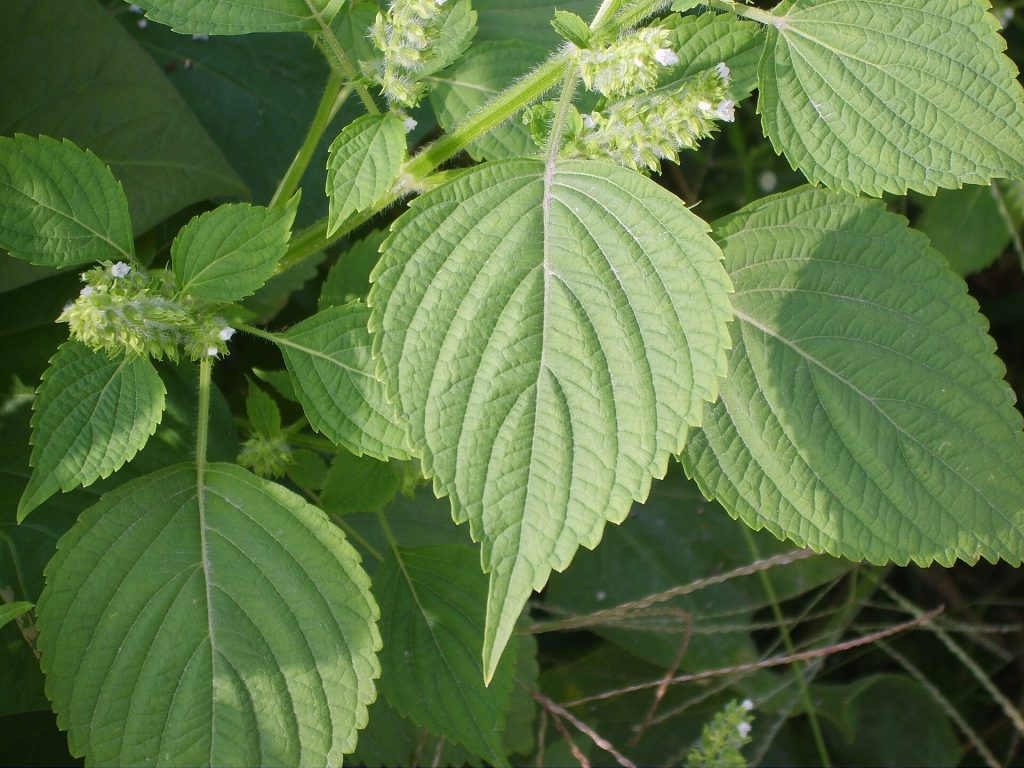
Perilla mint is known as Perilla frutescens in the scientific world. In my neck of the woods, we call it beefsteak plant or Chinese basil. Several varieties are prolific in city settings, making it a perfect plant to sink your teeth into.
When: Perilla pokes its head out when the weather gets warm and persists until the frost begins. I find prime specimens from July to November, though they can appear outside this window depending on where you live.
Where: Perilla is versatile. It loves damp soils and often grows alongside roads in drainage ditches. If you have a greenbelt in your city, search along its creek beds and understory. Perilla will also thrive in other areas with disturbed soil. Searching fields, feedlots, and barns on the outskirts of town may prove fruitful.
How: Perilla has a wonderfully spicy flavor and works well as an herb. Cooking it down dulls some of the heat. If you have an exceptionally large crop, you can cook it and use it like collards or spinach—it makes a slightly more aromatic green. I love making infused vinegar, spice rubs, and perilla soup with the leaves. Its seeds are full of heart-healthy omegas and have a nice flavor when pressed for oil.
Pro Tip: Perilla is great for humans but can make animals sick, so farmers, ranchers, and homeowners hate it. If you see patches growing on private property, it’s often worth asking if you can pick it. If the owner knows what it is, they may be thrilled to get rid of it!
4. Burdock
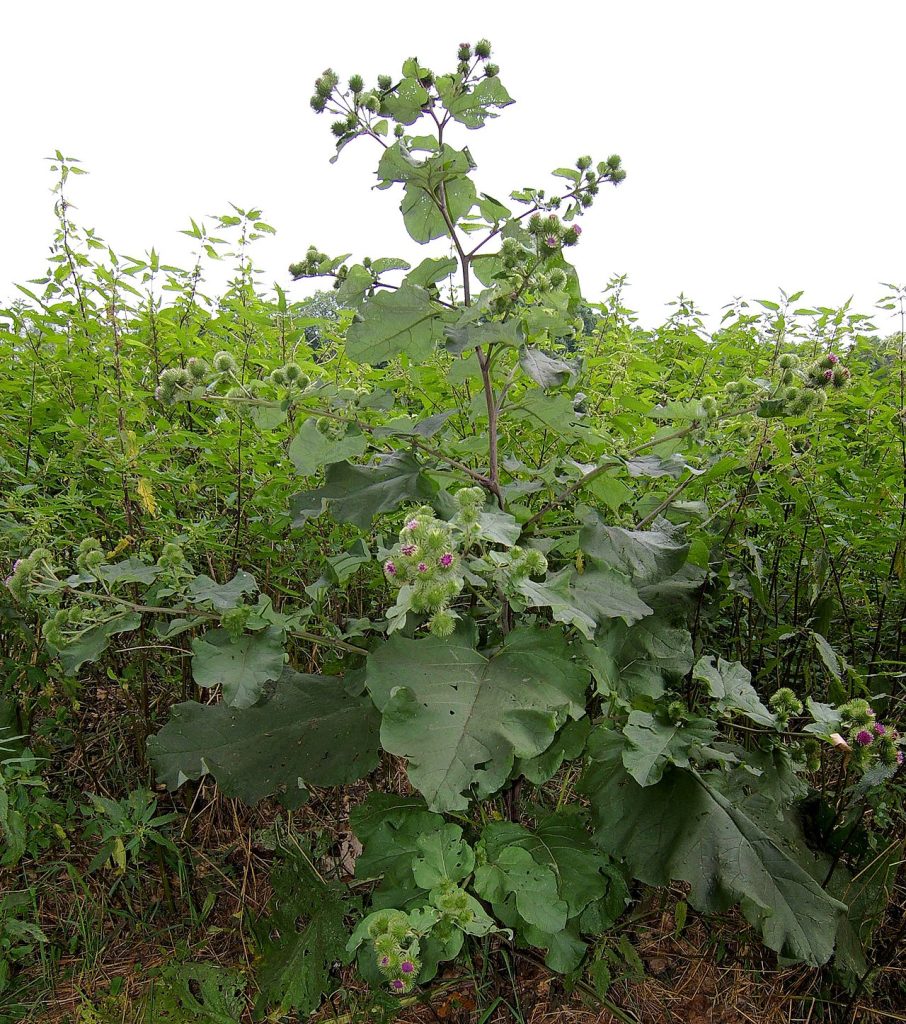
You’ve no doubt seen burdock before. This giant, ridiculous-looking biennial weed is a member of the Arctium family, and dozens of different edible varieties appear worldwide. You’ll recognize it by its spiky purple ball flowers, but it’s important to research which varieties grow in your area and familiarize yourself with how they look.
When: Burdock sprouts in spring and lives for two years. It develops a tasty taproot during the first year but sends up its flower shoot the next. For harvesting, it’s better to get at the plant before it flowers since it becomes bitter afterward. The optimal time for harvesting is the winter of a burdock plant’s first year since the root has grown enough to be worth the effort.
Where: Burdock hangs around trails and forest edges where the seed-spreading animals roam. You’ll find it where the soil has been disturbed on walkways, and it loves to mope around in vacant lots. Check around parks, ditches, and property lines where nobody likes to mow.
How: The best part of burdock is the root. Not only is it tender and flavorful when prepared correctly, but it’s also packed with antioxidants, vitamin B6, and potassium. The leaves are less delicious but are edible when cooked. You can use them as a wrap for cooking other items like you would use grape leaves or corn husks.
5. Cattails
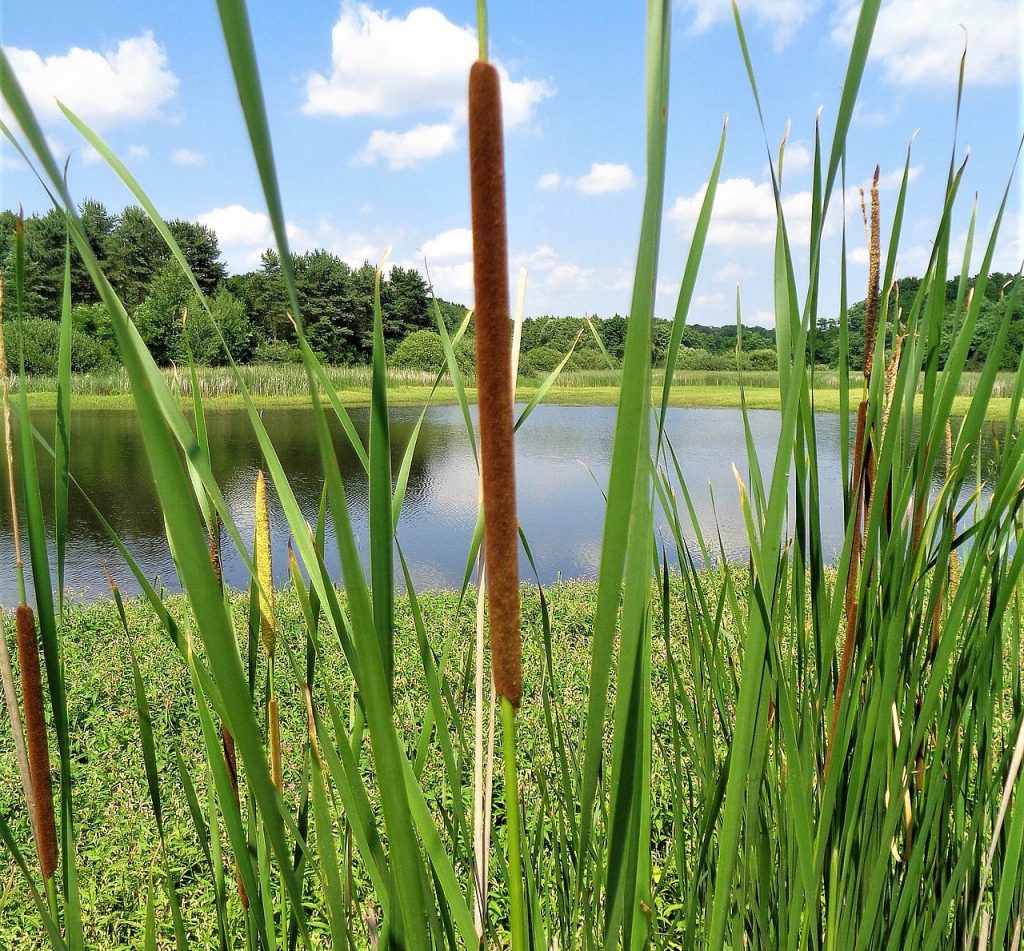
I’ve always called cattails “corndog plants” since the flowering parts are a dead-ringer for deep-fried dough cylinders. They don’t taste anything like corndogs, but they’re way healthier and much cheaper. I make these stately members of the Typha family a regular part of my spring diet every year, and I jar up the leftovers to enjoy throughout winter.
When: Cattails shoot up in spring and grow throughout the summer and into fall. The best part of the plant is the edible shoots, which are best harvested in late spring before the plant flowers. Once it blooms, you can still collect the buds and pollen for food.
Where: This is an aquatic plant. Cattails grow in standing water and thrive even in several inches of mud. You’ve got to get down and dirty to harvest them, but the result is worth the effort. They generally grow in dense clusters, so you can gather a lot in one go. Look in perpetually wet areas around your town, like drainage ditches, canals, and ponds.
How: Most parts of the cattail are edible, but the best part is the young shoot, which can grow over a foot in length. Once you harvest
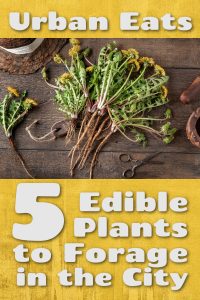
Pro Tip: If you see cattails one year, return to the same spot the following year to harvest tender shoots. You can sometimes find young cattail shoots where last year’s cattail is still visible.
Have you ever foraged for edible plants in the city?
Feeling hungry yet? I can’t blame you! Now that you know some common edibles to find in the city, you can head outside and get foraging no matter where you live.
Have you ever foraged any of the food mentioned here? Do you have any tips for other forages? Are there other wild edibles you recommend that are easy to find anywhere?
Let’s discuss it in the comments section!
About Lyza
Lyza Hayn is an Ozark native forest-dweller and seasoned survival kitchen whiz. Foraging is her passion, and wildcrafting is her (elderberry) jam. She knows how to gather, cook, and preserve hundreds of wild edibles, tincturing and pharmacrafting dozens more. By focusing on alternative food sources and natural remedies, Lyza knows we can all live a more independent lifestyle. Her mission is to help others utilize the world around them to reduce their dependence on established systems and create a more self-reliant future.
You can check out her website at www.letteredbylyza.com or follow her on Instagram @yourmountainhome to see her point of view in photographs.

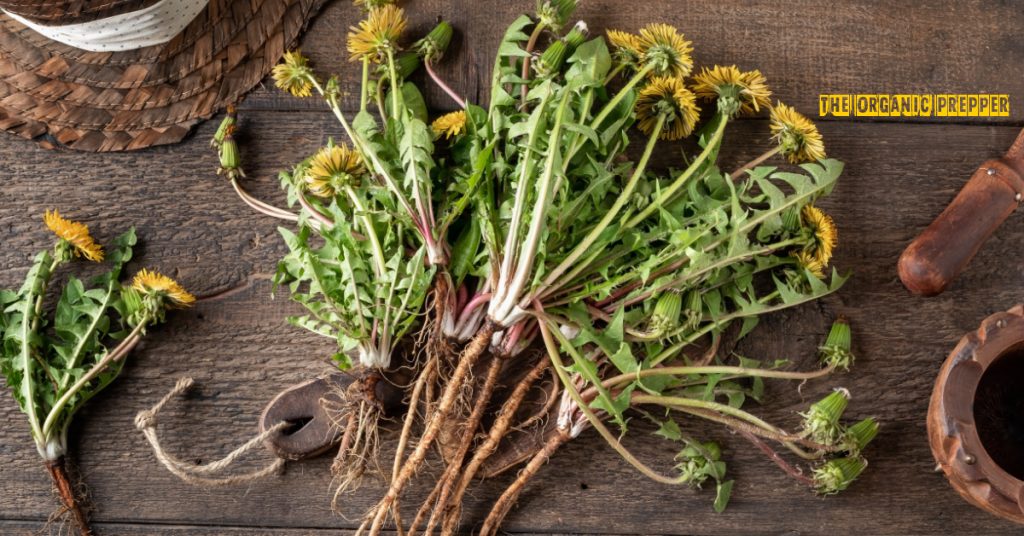















I woudn’t say these plants can be foraged anywhere. In parts of the south, they will not be found. I know because I live in the south. Plantain can be found but rarely. For anyone in the south, I would recommend Biden’s Alba, also known as Spanish Needle.
Great article and very practical advice! The large photos are very helpful. I’m trying to find a good book on Texas foraging, but need one with photos, not drawings because it’s difficult for me to recognize the plants that way. Any recommendations, anyone?
More articles like this one, please!
Texas is a weird one because it crosses so many different geographical regions! Where are you located in Texas? “Southwest Foraging” by John Slattery is an amazing resource for most parts of Texas.
North Texas, northwest of Ft. Worth.
I would say that Southwest Foraging by John Slattery would fit the bill for you!
Thank you! And yes, Texas terrain is very diverse. I’d rather live on the coast or in the Piney Woods but mostly am just happy to live here at all.
What a fun article! I had a relative that grew up on the South Side of Chicago, his mom regularly sent him out to get dandelion leaves for salads 🙂
The single biggest problem with foraging in urban areas and along hiways is the CHEMICALS that are sprayed and scattered everywhere! I have been teaching people for over 45 years …
The first 2 things that I teach are 1) ETHICS , ETHICS , ETHICS and 2) glyphosate aka weedkiller and bug poisons that are everywhere in th city and also along roadsides in both the city and countrside.
PEASE keep that in mind … I have seen people get sick from foraging .
And don’t forget industrial areas with heavy metals contamination ( that do not go away).
And agricultre run-off into small streams and ponds.
PLEASE BE AWARE AND BE SAFE!!!
In a situation where you were actually foraging for your daily bread, I wouldn’t be too concerned about the chemicals.
It’s a plant is able to grow there. You’re only gonna get trace amounts, but I would certainly rinse things off.
If you are on a municipal water supply, and the source is a river downstream from a large city, there are trace amounts of chemicals and drugs in that water because the residuals in the sewage out fall of the city above you.
I do my best to minimize the use of non-natural herbicides and insecticides in my garden with the use of mixing flowers and herbs and crop rotation, but sometimes I just have to do it to save a certain vegetable crop.
The best year I had I only used 1 pound of Seven dust the entire year.
LOTS of pursulane around here….good to eat in a variety of ways! also the roots of the almost ubiquitous tall orange day lilies are supposed to be good!
When I was much younger (much, much, much younger) and we lived way out in the boonies my father taught me about foraging in our area. I did quite a bit of it, especially after I turned 12, got my first single-shot .22RF rifle, and was expected to put food on the table. ‘
When I was hunting, every couple of days during rabbit and squirrel seasons, I would forage going toward my favored hunting area, as well as when I came back home.
Once we moved to a small town pickings (sic) were much more slim. Plus we went from a four real seasons area about 40 miles southwest of St. Louis, Missouri to the bootheel of Missouri. Big difference. I did have access to open wilderness and could forage there quite successfully. I did not do much because there were some not-very-nice people roaming the area all the time.
Now, in town was pretty prolific, without the dangers of trying to forage where the better selections were, but where bad people tended to be. I would keep an eye out whenever I was out doing a plumbing job. I found several places, including vacant lots that were literally full of edible plants.
After having trashed my left ankle my activities were much more limited. When I finally could I resumed by nightly walks. Which soon became a nightly run. I would stop occasionally and harvest whatever I had spotted at some point when it was easier to identify things.
I would not go onto private property without permission, but there were plenty of vacant lots with edible plants. And medicinal ones, too.
I did have to be somewhat selective where I harvested, as this was in town. A small town, yes, but with some streets carrying heavy traffic. Anything I found in these sections I was very careful to decontaminate very carefully.
Still, I was able to add quite a few wild edibles to my diet regularly. And was able to practice foraging for when I might need it at some point.
Just my opinion
Jerry
Jerry D Young
Hope for the best, prepare for the worst, and always remember TANSTAAFL
(“There Ain’t No Such Thing As A Free Lunch” Manny, from The Moon Is A Harsh Mistress by Robert A Heinlein)
I love learning about this stuff. Lyza, you certainly have a wealth of knowledge
to consider if you harvest wild plaant in the city is that if you do so near road with much traffic you will be harvesting a lot of car exhaust at the same time. So preferable to get these wild herbs away from where there is car fumes.
Thank you! Those certainly are accessible field herbs, and the precaution about chemicals is also very apt. Those 5 plants make a good starting core. Some other easy to find plants would be chicory and black mulberry.
Telling people that plants are there is good but falls short of the advice that is useful. having data on the typical area in which they may be found the parts that are the most easily processed and what they are used for. I have seen websites that have such information but it is usually large and in a form that requires much editing skills to transfer the data into useable form. providing a way to have a button that provides a printed copy that includes a picture. a clear description that provides a size comparison to a standard that is available and used for all. I know that in reality, all should have enough skills that should provide skills to provide a data list. Why do I ask for such data to be provided? Time! We spend so much time finding items that will provide the data, having found it would be grateful to have the data in a format that is accurate and provides accurate ways to use these plants to survive. The fact that it always takes time to learn to use all the plants in the best way, provides us with the most nutrients and food benefits. the final point makes the search for additional survival food easer cutting the time we need to evaluate the worth of the data that we recognize its value. Time isn’t wasted on reading everything and putting it into the format that is most useful. I know that a simple description with a recipe that starts with the most popular way to prepare these foods will have more viewers. Having this in hand becomes easier to organize and use when it is quickly needed. I had wanted to start a site with the title of starving with food at your feet. How many lives were saved and conflicts avoided with just simple information? For information to be useful it must be provided early in life so it becomes available instantly. Young students learn as if it is a game that would be stored away to be called upon when needed. information weighs nothing. Teaching at a young age when lessons learned will be there for them when the need arises. We provide students with so much trash that will never be used within their lifetime we need to expand their knowledge of what could be used. I apologize for my poor skills in grammar. I hope I have made my point.———— I, Grampa
Grampa,
Well spoken.
I am reminded of the opening line in the song, Kodachrome –
When I think back on all the crap I learned in high school it’s a wonder I can think it all
Though my lack of education did has hurt me none I can read the writing on the wall.
I don’t think they are even getting that skill anymore.
You have to consider you’re taking the entire society and giving them a snapshot of everything before they go off and specialize in a trade or college and even in college the discipline I studied was extremely broad and I never used 75% of it.
However, I knew enough to call BS within that 75%.
There’s no way a person writing an article like this can afford the time to do what you’re asking.
I’m not throwing stones at this writer and certainly not this site, but I have read a lot of sites and it’s obvious they’re harvesting their information from somebody else, repackage it, and making money due to the traffic and advertisements.
I’ve considered starting my own site, but to be honest, everything I would present is already out there somewhere.
Oh, I could really do is just give it a different slant.
I’ve got 25 books on gardening and plant identification and probably a dozen more on various skills.
They don’t require electricity and if they get wet, I can salvage them.
Stuff stored on the Internet or on your compute is like loose papers, laying on the table in the yard in the March breezes.
When you cannot access it, you only have what’s in your head.
So for anybody, that bothered to read this far you best get out there and study those skills and practice them.
And I will generally add to my comments that in addition to having the books already you best have a stockpile of seeds whether you live in the city or not because without seeds, the next crop is a dream.
But most importantly
Gods word tells us that the horse is prepared for the day of battle, but Safety is of the Lord.
Add acorns to the list.
I have a source somewhere that describes Indians processing hickory nuts by removing the outer husk, breaking them up with rocks, putting them in water and floating the shelves to the top, and the meat settles to the bottom.
Going to give that a try this year ‘s as well as processing the acorns.
I suppose the same can be done with walnuts.
Several videos out there, but I like this one the best because it’s showing the old ways.
I’ve got a several rocks I have collected over the years that have smooth spots from fingers, and a flat or rough spot at the impact point from the many hours of an Indian use them as a tool.
https://www.youtube.com/watch?v=x4-F5N63Cdo&pp=ygUQQWNvcm4gcHJvY2Vzc2luZw%3D%3D